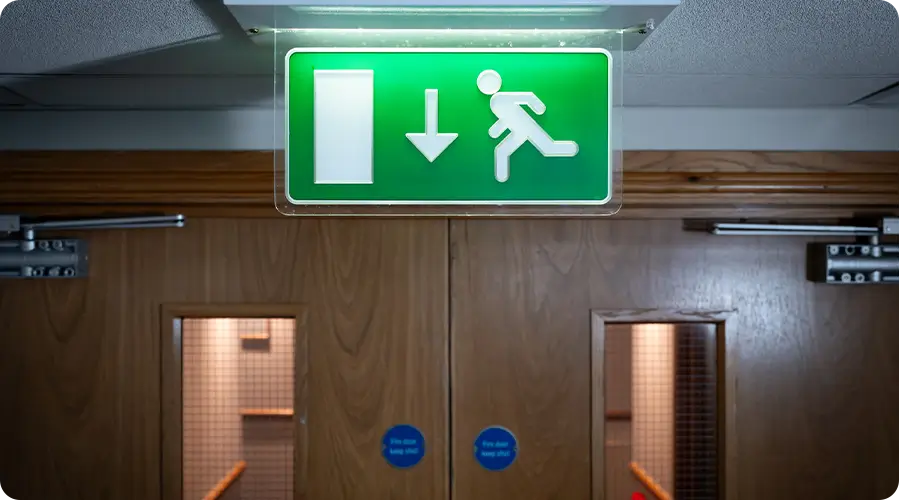When it comes to protecting property and saving lives, there are few components that are as important as fire doors. Due to this, it is essential that they are well maintained and upgraded where necessary through fire door inspections.
In this guide, we’ll discuss the current laws and legal requirements on fire doors, who is responsible for them and what parts of the doors must be inspected.
What are the current laws on fire doors in the UK?
Currently, fire doors are a legal requirement in all non-domestic properties such as office buildings and hospitals, as well as in flats and houses of multiple occupancy (HMO).
In both types of properties, fire doors must be installed to prevent the spread of fire and smoke in a building, as well as to provide a clear escape route. Fire doors are generally rated at a grade of FD30 and FD60.
FD30 fire doors are 45mm thick and are used in low-rise residential buildings and office buildings.
FD60 fire doors are 54mm thick and are installed in high-rise residential and non-residential buildings.
Under the Code of Practice for Fire Door Assemblies, any fire door installed in a premises needs to provide a similar level of resistance to the fixed elements within the building, such as the walls and floors.
The Fire Safety (England) Regulations 2022 require that fire doors are also built with the following:
Fire doors must also meet specific standards, including:
Book in a Fire Door Inspection Today
Is there a legal requirement to inspect fire doors?
Yes, under the Fire Safety(England) Regulations 2022 and the Regulatory Reform (Fire Safety) Order 2005, fire doors must be inspected every 3-6 months, with more frequent checks for heavily used doors. This is essential to ensure fire doors are adequately maintained and kept in line with regulations.
During a fire door inspection, you should inspect the door’s condition and appearance, including seals, hinges, frames, as well as looking out for any obvious signs of damage.

"Fire door inspection IMG_5083" by West Midlands Fire Service is licensed under CC BY-SA 2.0.
Business responsibility under fire door legislation
In England and Wales, businesses have a legal responsibility to ensure fire safety, which includes all fire doors in their property.
Your business must appoint a responsible person to inspect the buildings fire doors and record their findings under a fire door inspection checklist.
If you do not feel comfortable conducting fire door inspections yourself, or you simply don’t have the time to do so, you will need to appoint a responsible person for you. This is where our team at Lanahan Risk Management Services can help.
Our comprehensive fire door inspection services are non-destructive and non-intrustive, consisting of a number of different checks to ensure that the building and everyone inside it is safe.
How fire doors should be inspected
No matter where you are inspecting a fire door or what type of building it is in, you must be aware of the following signs that demonstrate the door will need to be replaced:
You can find out more on the specific elements that need to be inspected of different doors by reviewing government guidelines.
How often do fire doors need to be inspected?
Under the Regulatory Reform (Fire Safety) Order 2005, it is recommended that fire doors are inspected every 6 months.
However, more frequent inspections are highly recommended for high traffic areas where the doors may be used more often or be exposed to harsher conditions.
How often you inspect your property’s fire doors may also vary depending on your local area requirements, industry standards and even your insurance provider. However, regardless of these factors, you should ensure the fire doors are checked every 6 months.
Should you record fire door inspections?
Yes, it is a legal requirement that you always record your fire door inspections. It is crucial that your findings are recorded as it acts as a trail and will ensure you are legally compliant if a fire related accident were to happen and the doors functionality was questioned.
Recording details of any defects or damage found during the inspection is crucial as it allows for timely repairs and necessary preventative maintenance. In the case of an incident, documented inspections can also help to serve as evidence that you were actively managing fire door safety.
Keep your Premises Safe with a Fire Door Inspection
The importance of fire door inspections
Fire door inspections are a crucial part of your property’s fire safety culture. Not only are fire door inspections a legal requirement, but they are an essential part of your building’s passive fire protection system.
Having the correct fire doors installed can save lives and drastically reduce the amount of damage to your property. This is why it is imperative that they receive regular inspections to maintain them. If those responsible are found to have not maintained the fire doors correctly, they will likely face penalties such as fines, legal action and even imprisonment.

